A drug is given to an animal that completely blocks the absorption of nutrients within the digestive system. Which of the following structures is most severely impacted by this treatment?
Intestine
Buccal cavity
Crop
Stomach
The correct Answer is:A
To solve the question regarding which structure is most severely impacted by a drug that blocks the absorption of nutrients within the digestive system, we can follow these steps:
1. Understanding the Question: The question states that a drug is given to an animal that completely blocks the absorption of nutrients in the digestive system. We need to identify which structure in the digestive system would be most affected by this blockage.
2. Identifying the Structures: The options provided are:
- A) Intestine
- B) Buccal cavity
- C) Crop
- D) Stomach
3. Analyzing Each Option:
- Buccal Cavity: This is where the food is initially processed (masticated) with the help of teeth and saliva. However, absorption does not occur here.
- Crop: This is an organ found in some animals (like birds) that stores food temporarily. It does not play a significant role in nutrient absorption.
- Stomach: The stomach is primarily involved in the digestion of food, breaking it down into a semi-liquid form, but it is not the main site for nutrient absorption.
- Intestine: The small intestine is the primary site for the absorption of nutrients. This is where digested food is absorbed into the bloodstream.
4. Conclusion: Since the question specifically mentions the blockage of nutrient absorption, the structure that would be most severely impacted is the intestine, particularly the small intestine, where the majority of nutrient absorption occurs.
Final Answer:
The structure most severely impacted by the drug that blocks the absorption of nutrients is A) Intestine.
---
- A) Intestine
- B) Buccal cavity
- C) Crop
- D) Stomach
- Buccal Cavity: This is where the food is initially processed (masticated) with the help of teeth and saliva. However, absorption does not occur here.
- Crop: This is an organ found in some animals (like birds) that stores food temporarily. It does not play a significant role in nutrient absorption.
- Stomach: The stomach is primarily involved in the digestion of food, breaking it down into a semi-liquid form, but it is not the main site for nutrient absorption.
- Intestine: The small intestine is the primary site for the absorption of nutrients. This is where digested food is absorbed into the bloodstream.
The structure most severely impacted by the drug that blocks the absorption of nutrients is A) Intestine.
Topper's Solved these Questions
- DIGESTION AND ABSORPTIONBOOK - AAKASH SERIESCHAPTER - DIGESTION AND ABSORPTIONEXERCISE - Exercise - II(Absorption of Nutrients)
7 Videos
- DIGESTION AND ABSORPTIONBOOK - AAKASH SERIESCHAPTER - DIGESTION AND ABSORPTIONEXERCISE - Exercise - II(Disorders of Digestive system)
6 Videos
- DIGESTION AND ABSORPTIONBOOK - AAKASH SERIESCHAPTER - DIGESTION AND ABSORPTIONEXERCISE - Exercise - II(Digestive Glands)
15 Videos
- CHEMICAL COORDINATION AND INTERGRATIONBOOK - AAKASH SERIESCHAPTER - CHEMICAL COORDINATION AND INTERGRATIONEXERCISE - Exercise-III (previous AIPMT/NEET questions)
41 Videos
- EVOLUTIONBOOK - AAKASH SERIESCHAPTER - EVOLUTIONEXERCISE - EXERCISE - III( PREVIOUS AIPMT/NEET QUESTIONS)
38 Videos
Similar Questions
Knowledge Check
The given figure illustrates montly changes in the human ovary during the reproduction cycle.

Which of the following statements most accurately describes each structure?ABefore puberty, the oocyte (A) does not start the process of meiosis.BThe hormone produced by by structure (B) causes thinning of the uterine cervical mucus to allow passage of sperms.CDuring ovulation, structure (C) stays at the interphase between meiosis I and meiosis II.DThe hormone produced by structure (D) stimulates the pituitary gland to secrete luteinising hormone.Which of the following is incorrect regarding the given digestion and absorption of protein?
AThe breakdwon of proteins to peptides is catalyzed by pepsin in the stomach and by the pancreatic enzymes trypsin and chymotrypsin in the small intestine.BPeptides are broken down into amono acids by pancreatic carboxypeptidase and intestinal aminopeptidase.CSmall peptides consisting of two or three amono acids can diffuse through epithelial cell and broken down into carbon dioxide and ammonia which are released into the blood.Dnone of theseThe given graph shows the range of variation among population members for a trait determined by multiple genes. If this population is subjected to disruptive selection for several generations, which of the following distributions is most likely to result?
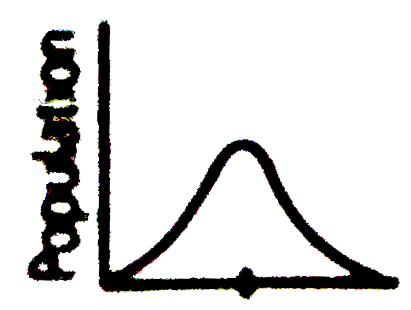 A
A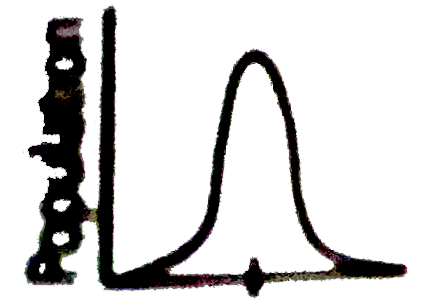 B
B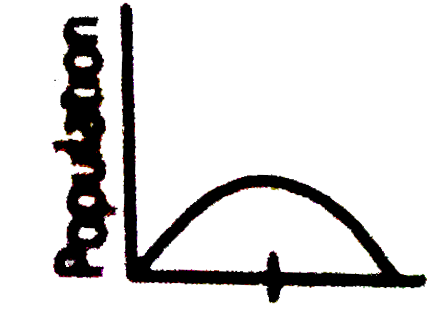 C
C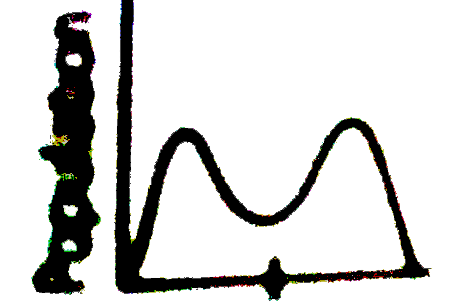 D
D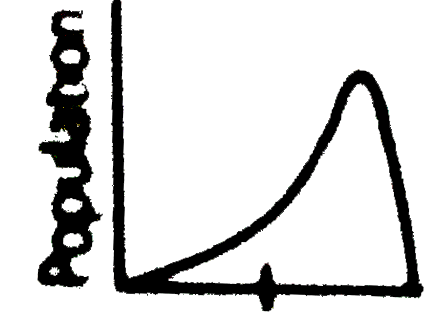
Consider the following statements (A-D) each with one or two blanks.
(A) Four characters of chordates are the presence of (i)_____ dorsal hollow nervous system, (ii)_____ and muscular tail
(B) Agnatha are the most primitive craniates. They are commonly called (iii)_____ vertebrates
(C) Electric ray belongs to class (iv)_____ while sea horse belongs to class (v)_____
(D) (vi)_____ are also defined as feathered bipeds. These have a (vii)_____ gland on the tail
Which one of the following options, correctly fills any two of the given statements ?
View SolutionChemistry of Cooking we tend to think of cooking as an art, but much of its basis actually comes from chemistry. Let's take, for instance, the example of cooking meat. Why do we bother with cooking meat? For one, it kills the bacteria that can live in meat and be harmful to us. But additionally, it makes the meat much more tender-easier to eat and easier to digest. Typically, protein is the second-highest component of meat behind water. Proteins have several levels of organization. A protein's primary structure is the order in which the amino acids are joined by their peptide bonds. A protein's secondary structure is made up of local interactions of the primary structure. Secondary structure includes alpha helices, beta sheets, turns, and loops. Tertiary structure is formed when various secondary structures interact, typically over long distances. Finally, quaternary structure is the interaction of different protein subunits. Proteins fold tightly in complex ways that are energetically and sterically favorable. So what happens to this complex organization when meat is heated? These interactions become weaker. Proteins denature, meaning their interactions weaken and their quaternary, tertiary, and secondary structures break down. Instead of tightly folded proteins, they become loose and stretched out. This denaturation is what makes meat more tender. However, continuing to cook meat after this initial denaturation serves only to remove water, making the meat tougher and drier. In particular, the denaturation of collagen makes meat more tender. Collagen is the most abundant protein in animal connective tissue. Tougher cuts of meat tend to have more connective tissue, and thus more collagen. But heating proteins isn't the only way to denature them: they can also be denatured by adding certain denaturing substances. Many of these substances, like strong acids and bases, you wouldn't want to add to your food, however, one common denaturing agent is salt. This is why you may want to brine a tougher cut of meat in addition to cooking it. Brining involves soaking something in a solution of salt water. Another benefit of brining is that when the meat absorbs the salt, this draws water into the meat to dilute the salt. Thus, brining also serves to keep meat moist. Some chefs will advise searing the outside of a cut of meat before cooking it through to lock in the moisture. However, chemistry doesn't support this approach: steam is equally capable of escaping through a seared crust as it is through non-seared meat. If you've ever cooked red meat, you know that as it cooks, it turns brown. Red meat is red because of its high myoglobin content. Myoglobin is an oxygen-storing protein found in muscle cells, it is associated with an iron atom. Before the meat is cooked, the iron atom is in the +2 oxidation state, cooking it removes an electron, thus changing it to the +3 oxidation state. This transforms the color to brown. On the other hand, white meat doesn't turn brown because it doesn't have nearly as much myoglobin to be oxidized. We rarely pause mid-recipe to consider the chemistry of cooking, but understanding the chemical reactions occurring in our food will help us to become better cooks. Isn’t that some food for thought?
it can be reasonably inferred from the passage that which of these protein structures is least impacted by heating?
View SolutionThe chemical formula of deoxyribonucleic acid
(DNA) is now well established. The molecule is a
very long chain, the backbone of which consists of a
regular alternation of sugar and phosphate groups.
5 To each sugar is attached a nitrogenous base, which
can be of four different types. Two of the possible
bases—adenine and guanine—are purines, and the
other two—thymine and cytosine—are pyrimidines.
So far as is known, the sequence of bases along the
10 chain is irregular. The monomer unit, consisting of
phosphate, sugar and base, is known as a nucleotide.
The first feature of our structure which is of
biological interest is that it consists not of one chain,
but of two. These two chains are both coiled around
15 a common fiber axis. It has often been assumed that
since there was only one chain in the chemical
formula there would only be one in the structural
unit. However, the density, taken with the X-ray
evidence, suggests very strongly that there are two.
20. The other biologically important feature is the
manner in which the two chains are held together.
This is done by hydrogen bonds between the bases.
The bases are joined together in pairs, a single base
from one chain being hydrogen-bonded to a single
25 base from the other. The important point is that only
certain pairs of bases will fit into the structure.
One member of a pair must be a purine and the other
a pyrimidine in order to bridge between the two
chains. If a pair consisted of two purines, for
30 example, there would not be room for it.
We believe that the bases will be present almost
entirely in their most probable forms. If this is true,
the conditions for forming hydrogen bonds are more
restrictive, and the only pairs of bases possible are:
35 adenine with thymine, and guanine with cytosine.
Adenine, for example, can occur on either chain, but
when it does, its partner on the other chain must
always be thymine.
The phosphate-sugar backbone of our model is
40 completely regular, but any sequence of the pairs of
bases can fit into the structure. It follows that in a
long molecule many different permutations are
possible, and it therefore seems likely that the precise
sequence of bases is the code which carries the
45 genetical information. If the actual order of the bases
on one of the pair of chains were given, one could
write down the exact order of the bases on the other
one, because of the specific pairing. Thus one chain
is, as it were, the complement of the other, and it is
50 this feature which suggests how the deoxyribonucleic
acid molecule might duplicate itself.
The table shows, for various organisms, the percentage of
each of the four types of nitrogenous bases in that
organism’s DNA.
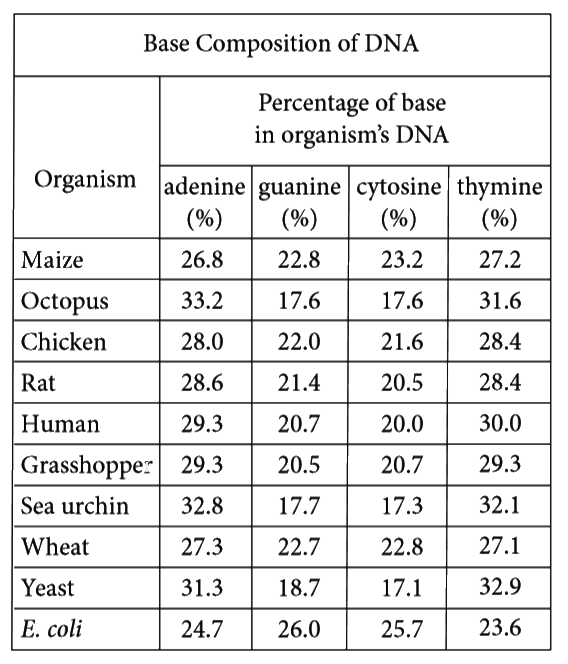
Adapted from Manju Bansal, “DNA Structure: Revisiting the
Watson-Crick Double Helix.” ©2003 by Current Science Association,
Bangalore
23. A student claims that nitrogenous bases pair randomly with one another. Which of the following statements in the passage contradicts the student’s claim?
View SolutionPhase I clinical trails are run to determine the safely of all new drugs, especially with respect to the severily and duration of side effects. A physician is overseeing a phase I trial based on 8000 heathly participants. Half of the participants are given the drug, and half are given an inert pill. The mean duration of side effects for those participants who were given the drug was 72 hours with a margin of error of 6 hours. The physician is planning to replicate the trial in an attempt to decrease this margin of error. Which of the following will most likely lead to a decrease in the margin of error for the mean duration of side effects?
View SolutionChemistry of Cooking we tend to think of cooking as an art, but much of its basis actually comes from chemistry. Let's take, for instance, the example of cooking meat. Why do we bother with cooking meat? For one, it kills the bacteria that can live in meat and be harmful to us. But additionally, it makes the meat much more tender-easier to eat and easier to digest. Typically, protein is the second-highest component of meat behind water. Proteins have several levels of organization. A protein's primary structure is the order in which the amino acids are joined by their peptide bonds. A protein's secondary structure is made up of local interactions of the primary structure. Secondary structure includes alpha helices, beta sheets, turns, and loops. Tertiary structure is formed when various secondary structures interact, typically over long distances. Finally, quaternary structure is the interaction of different protein subunits. Proteins fold tightly in complex ways that are energetically and sterically favorable. So what happens to this complex organization when meat is heated? These interactions become weaker. Proteins denature, meaning their interactions weaken and their quaternary, tertiary, and secondary structures break down. Instead of tightly folded proteins, they become loose and stretched out. This denaturation is what makes meat more tender. However, continuing to cook meat after this initial denaturation serves only to remove water, making the meat tougher and drier. In particular, the denaturation of collagen makes meat more tender. Collagen is the most abundant protein in animal connective tissue. Tougher cuts of meat tend to have more connective tissue, and thus more collagen. But heating proteins isn't the only way to denature them: they can also be denatured by adding certain denaturing substances. Many of these substances, like strong acids and bases, you wouldn't want to add to your food, however, one common denaturing agent is salt. This is why you may want to brine a tougher cut of meat in addition to cooking it. Brining involves soaking something in a solution of salt water. Another benefit of brining is that when the meat absorbs the salt, this draws water into the meat to dilute the salt. Thus, brining also serves to keep meat moist. Some chefs will advise searing the outside of a cut of meat before cooking it through to lock in the moisture. However, chemistry doesn't support this approach: steam is equally capable of escaping through a seared crust as it is through non-seared meat. If you've ever cooked red meat, you know that as it cooks, it turns brown. Red meat is red because of its high myoglobin content. Myoglobin is an oxygen-storing protein found in muscle cells, it is associated with an iron atom. Before the meat is cooked, the iron atom is in the +2 oxidation state, cooking it removes an electron, thus changing it to the +3 oxidation state. This transforms the color to brown. On the other hand, white meat doesn't turn brown because it doesn't have nearly as much myoglobin to be oxidized. We rarely pause mid-recipe to consider the chemistry of cooking, but understanding the chemical reactions occurring in our food will help us to become better cooks. Isn’t that some food for thought?
according to the passage, which of these cooking approaches would have the most negligible effect on the tenderness of meat?
View Solution
